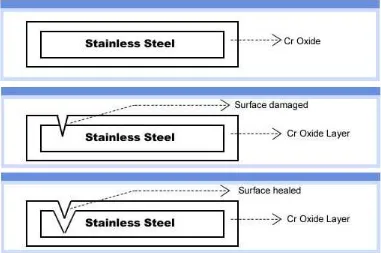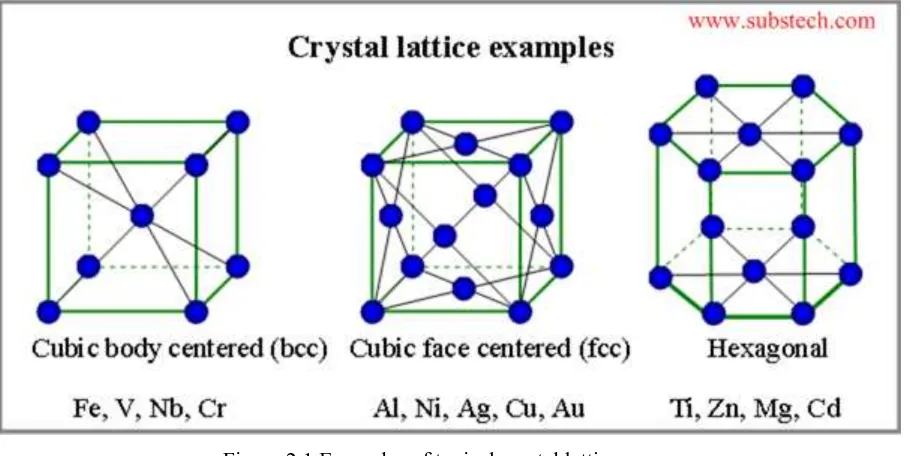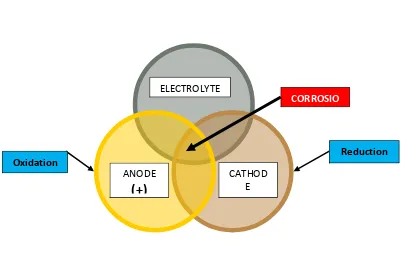i
SUPERVISOR DECLARATION
“I hereby declare that I have read this thesis and in my opinion this report is sufficient in terms of scope and quality for the award of the degree of
Bachelor of Mechanical Engineering (Structure and Materials)”
ii
A STUDY THE MATHEMATICAL MODELING OF CORROSION IN STAINLESS STEEL
ZULHELMI BIN SAAD
This Report Is Submitted In Partially Fulfillment of Requirement for the Bachelor Degree of Mechanical Engineering (Structure and Material)
Faculty of Mechanical Engineering Universiti Teknikal Malaysia Melaka
iii
DECLARATION
“I hereby declare that the work in this report is my own except for summaries and quotations which have been duly acknowledged.”
Signature :………..
Author : ZULHELMI BIN SAAD
iv
This thesis is dedicated to my parents who have never failed to give me moral support and also for my supervisor who teaching me that even the largest task can be
v
ACKNOWLEDGEMENT
All praises and thanks be to Allah S.W.T, who has guided us to this, never could we have found guidance, were it not that Allah had guided us! (Quran 7:43). All praises again to the All Mighty Allah with His permission, I managed to carry out the study with His blessings of health, opportunity and knowledge.
The special thanks go to my supervisor Pn Suhaila Binti Salleh for giving me the opportunity to been in her supervision for this project and do teach me a lot to finish my PSM 1.
Special thanks also to my parents Saad Bin Zakaria and Rohani Binti Abd. Majid because give me all their support since I was young until I can enter University Teknikal Malaysia Melaka and end up my studied here. I really appreciate for all what they had done for me.
Thank you also for those who have helped me directly and indirectly in making this report, my fellow friend that give me a lot of support, to my panel that gives me so much comment to enhance my study about this project.
vi
ABSTRACT
vii
ABSTRAK
viii
TABLE OF CONTENT
CHAPTER TOPIC PAGE
SUPERVISOR DECLARATION i
STUDENT DECLARATION iii
DEDICATION iv
ACKNOWLEDGEMENT v
ABSTRACT vi
TABLE OF CONTENT vii
LIST OF TABLES xi
LIST OF FIGURES xii
LIST OF SYMBOL xiv
1 INTRODUCTION 1
1.1 BACKGROUND 1
1.2 PROBLEM STATEMENT 4
1.3 OBJECTIVES 5
ix
2 LITERATURE REVIEW 4
2.1 TYPES OF STAINLESS STEEL 6
2.2 CORROSION 8
2.3.1 Equation of corrosion reactions 10
2.3 CATEGORIES OF CORROSION OF
STAINLESS STEEL 11
2.3.1 General Corrosion 12
2.3.2 Pitting Corrosion 15
2.3.3 Crevice Corrosion 17
2.3.4 Stress Corrosion Cracking (SCC) 18
2.3.5 Sulfide Stress Corrosion Cracking (SSC) 19
2.3.5.1 Stress Level 19
2.3.5.2 Environment 20
2.3.5.3 Temperature 20
2.3.6 Intergranular Corrosion 20
2.3.7 Galvanic Corrosion 22
2.3.8 Contact Corrosion 25
2.4 COMSOL MULTIPHYSICS 26
2.5 POURBAIX DIAGRAMS 27
3 METHODOLOGY 31
3.1 INTRODUCTION 31
3.1.1 Project Flow Chart 32
3.1.2 Project Flow Chart Diagram 33
3.2 COMSOL Multiphysics 34
3.3 Model Example: Electrochemical Polishing 35
3.4 Create the Model of Stainless Steel 38
3.5 Mathematical Modelling 38
3.6 Constant input 39
3.7 Expression of the model 40
3.7.1 Boundary expressions 40
x
4 RESULTS AND DISCUSSIONS 42
4.1 Result 42
4.2 Discussions 43
5 CONCLUSION 47
6 REFERENCES 48
xi
LIST OF TABLES
NO TITLE PAGE
1.1 Differences between normal carbon steel and stainless 2 steel resistence to corrosion.
1.2 Oxidizing and Reducing 26
xii
LIST OF FIGURES
NO TITLE PAGE
1.1 Group of Steel 1
1.2 Self-healing effect of stainless steel 3
2.1 Examples of typical crystal lattice 8
2.2 Three importants principle in corrosion 10
2.3 Schematic of corrosion mechanism of iron 10 2.4 Isocorrosion diagram for pure sulphuric acid, 0.1 mm/year 13 2.5 Limiting concentrations for passivity in sulphuric acid
for various stainless steels. 13
2.6 The effect of impurities on the corrosion resistance
of 316L (2.5% Mo min.) in sulphuric acid. 14
2.7 Pitting on a tube of AISI 304 used in brackish water 15 2.8 Temperature at which pitting corrosion is likely to occur 16 2.9 Stress corrosion cracking adjacent to a weld in
a stainless pipe exposed to a chloride-containing 18 2.10 Corrosion action of water droplet scematic on metal surface 22 2.11 Galvanic corrosion on mild steel welded to
stainless steel and exposed to sea water. 23
2.12 Galvanic series for metals in flowing sea water. 23
2.13 Windows display of COMSOL Multiphysics 25
2.14 Pourbaix diagram 27
3.1 Project Flowchart 32
3.2 Model geometry 34
xiii
3.6 Polarization curve (Evans diagram) 37
3.7 Model of stainless steel 38
4.1 Corrosion of model result 42
4.2 Graph showing the polarization curve at the bottom of pit 44 4.3 Profiles of concentration of all species at the bottom of the pit 45
xiv
LIST OF SYMBOLS
E0 = Standard electrode potential, V n = Number of electrons transferred Cion = Molar activity (concentration) of ions
K = Kelvin
V = Volt
R = Gas constant
F = Faraday’s constant
D = Diffusion
k = kinetic constant
1
CHAPTER 1
INTRODUCTION
1.0 BACKGROUND
Stainless steel represents one of the more recent groups of steel group (Figure 1). Although invented at the beginning of the 20th Century, it took several decades before their use became widespread in the world. It came from steel family consist of Carbon Steel, Alloy Steel & Stainless Steel (see Figure 1.1).
Figure 1.1 Group of Steel STEEL
Carbon Stainless
Ferritic
Martensitic Austenitic
2
Stainless steels are generally very corrosion resistant and perform satisfactorily in most environments. The limit of corrosion resistance of a given stainless steel depends on its alloying elements which means that each grade has a slightly different response when exposed to a corrosive environment. Care is therefore needed to select the most accurate grade of stainless steel for a given application. Generally, the higher the level of corrosion resistance required, the higher the level of alloying elements and the greater the cost of the material.
All stainless steels are iron-based alloys that contain a minimum of around 10.5% Chromium. The chromium in the alloy forms a self-healing protective clear oxide layer (see Figure 1.2). This oxide layer gives stainless steels their corrosion resistance. The self healing nature of the oxide layer means the corrosion resistance remains intact regardless of fabrication methods. Even if the material surface is cut or damaged, it wills self heal and corrosion resistance will be maintained (see Table 2.1).
NORMAL CARBON STEEL
Fe + C + Mn = Carbon Steel
Carbon Steel + O2 = RUST
STAINLESS STEEL
Fe + C + Mn + Cr = Stainless Steel
3
Table 1.1 Differences between normal carbon steel and stainless steel resistence to corrosion
Self-healing effect of stainless steel that chromium oxide is a thin and transparent passive layer of chromium oxide that allows the natural beauty of stainless steel to remain intact. It is also self-healing and forms readily in air.
Figure 1.2 Self-healing effect of stainless steel (Source: www.hoto.com)
4
1.1 PROBLEM STATEMENT
5
1.2OBJECTIVES
• To study the occurrence of corrosion activity in stainless steel.
• To construct mathematical equation based on the kinetics of corrosion of stainless steel.
1.3SCOPES
• Literature review on stainless steel and corrosion principles, its relation to Pourbaix diagram of iron.
• Theory of corrosion kinetics: • Oxidation (anedic) • Reduction (cathodic) • Hydrolysis
• Simulate the corrosion activities by using COMSOL Multiphysics.
6
CHAPTER 2
LITERATURE REVIEW
2.1 TYPES OF STAINLESS STEEL
The most common alloys of stainless steel used in under three main groups;
1. Austenitic 2. Ferritic 3. Martensitic
7
treatable and may be hardened only by cold work. Applications of austenitic stainless steels such as chemical equipment, food equipment, kitchen sinks, medical devices, heat exchangers, parts of furnaces and ovens.
Ferritic stainless steels contain chromium only as alloying element. The crystallographic structure of the steels is ferritic, BCC crystal lattice (see figure 2.1) at all temperatures. The steels from this group are low cost and have the best machinability. The steels are ferromagnetic. Ductility and formability of ferritic steels are low. Corrosion resistance and weldability are moderate. Resistance to the stress corrosion cracking is high. Ferritic steels are not heat treatable because of low carbon concentration and they are commonly used inannealed state. Applications of ferritic steels such as decorative and architectural parts, automotive trims and exhausting systems, computer floppy disc hubs, hot water tanks.
8
Figure 2.1 Examples of typical crystal lattice (Source http://www.substech.com)
The types of corrosion in some environments and care must be taken to select a grade which will be suitable for the application. Corrosion can cause a variety of problems, depending on the applications:
o Perforation such as of tanks and pipes, which allows leakage of fluids or gases, o Loss of strength where the cross section of structural members is reduced by
corrosion, leading to a loss of strength of the structure and subsequent failure, o Degradation of appearance, where corrosion products or pitting can detract from
a decorative surface finish,
o Finally, corrosion can produce scale or rust which can contaminate the material being handled; this particularly applies in the case of food processing equipment.
2.2 CORROSION
9
corrosion involves the transfer of electrons between a metal surface and an aqueous electrolyte solution.
Many of nonmetallic, such as ceramics, consists of metal that have their chemical reactivity satisfied by the formation of bond with other reactive ions, such as oxides and silicates1. Metal corrode because of the electrovalent of ions is not stable. Corrosion has been classified in two different ways. One of the methods explains that corrosion can be dividing into low temperature and high temperature. But the most preferred classification of corrosion is wet corrosion and dry corrosion. Figure 2.3 is a general schematic for the corrosion mechanism. Concentration cells may also be formed where there are differences in metal ion concentration. A copper pipe in contact with copper ion solutions of different concentrations will corrode at the part in contact with the more dilute solution.
Corrosion is considered to involve electrochemical processes; that is, chemical changes caused by electrical potential differences (voltage gradients). For corrosion to occur, in simple terms, three components must be present, as indicated schematically in Figure 2.2. These three components are:
• Anedic (oxidation) is an anode or electrode where there are excess electrons (negative potential) because of the release of positively charged ions into the electrolyte; i.e., corrosion occurs.
• Cathodic is a cathode (or counter electrode where electrons are consumed by the discharge of ions in the electrolyte).
• An electrolyte (or conductive medium that allows an ionic current to flow to maintain a charge balance).
1
10
Like most other chemical reactions, corrosion rates increase as temperature increases. Temperature and pressure of the medium govern the solubilities of the corrosive species in the fluid, such as oxygen (O), carbon dioxide (CO), chlorides, and hydroxides.
2.2.1 Equation of corrosion reactions
Figure 2.3 Schematic of corrosion mechanism of iron ELECTROLYTE
ANODE
(+)
CATHOD E
CORROSIO
Figure 2.2 Three importants principle in corrosion Oxidation



